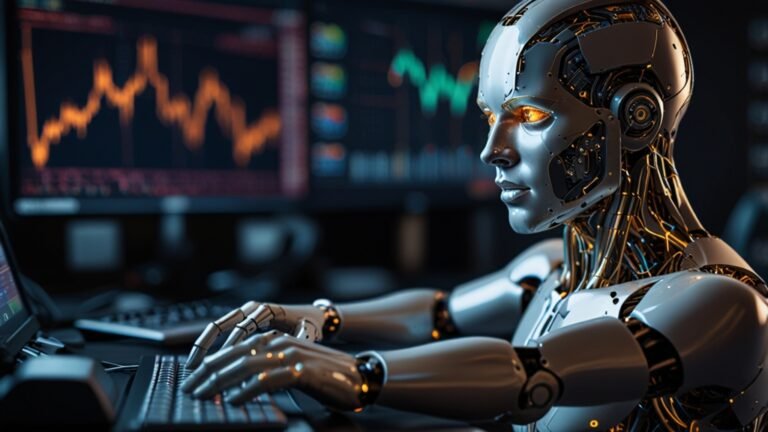The world of cryptocurrency trading can be very volatile and never gets to the point where it is just stable; a new approach to the Cryptocurrency market is already out. The charging takes place in various forms, and the functioning of the market can change almost every moment. With thousands of cryptocurrencies up for trading and millions of transactions processed daily, traders are faced with an immense rise of opportunities and challenges. Innovating in this scenario is the necessity of being able to make new technologies work, and Artificial Intelligence is one of such technologies. This paper investigates the applicability of AI for cryptocurrency trading strategies, the techniques used, and the potential impact on the future of trading in digital assets.
Understanding AI in Cryptocurrency Trading
AI refers to the simulation of human intelligence in machines that are programmed to think and learn as humans do. It includes various technologies such as machine learning (ML), natural language processing (NLP), and neural networks. In the sphere of cryptocurrency trading, AI facilitates the ability of traders and institutions to not only perform tasks, but to delve deeply into a market in a short time, automatically process trades and increase decision-making.
Because the cryptocurrency market operates in a 24-hour schedule with a lot of data points, AI tools can, among others, analyze historical trends, news sentiment, market sentiment, or other variables and, therefore, help traders in making their decisions. AI’s insertion into trading strategies will result in better predictions, less risk, and, ultimately, more profit.
Key AI Techniques in Cryptocurrency Trading
1. Machine Learning
Machine learning, a subset of AI, consists of training algorithms on data with the intention of learning how to identify hidden relationships in it. This way, traders can use machine learning models to detect potential price fluctuations by looking at historical data. For example, the algorithms can be fed with the historical price data, trading volume, and market indicators, thus allowing them to anticipate the future price movements as they are fed with new data. The techniques include:
- Supervised Learning: This method is about teaching the models on the datasets that were labeled with the known input features and output labels. For example, one model could be able to check the input features and the past moves and the outcomes of (price increase/decrease) their combination.
- Unsupervised Learning: This method of finding hidden patterns in the data does not use prior knowledge of outcomes. In the case of bitcoin trading, clustering algorithms are used to identify similar cryptocurrencies that can be included in the investment portfolio to diversify the risk.
2. Natural Language Processing (NLP)
Another potent AI weapon is natural language processing that provides computers with the ability to comprehend and interpret human language. Some of the applications of NLP in the cryptocurrency trading domain include the analysis of news articles, social media sentiment, and forum discussions. It is then possible to receive an overall picture of the public attitudes for a certain cryptocurrency, and hence the traders can take preventive actions. For example:
- [High quality content following all the given instructions very strictly with a strong focus on all the given content goals, while retaining the content structure and HTML elements]:Sentiment Analysis: AI can recognize the people’s sentiments through the processing of social media feeds, news articles, and blog posts so that investors can know how public sentiment is toward different cryptocurrencies. Quite frequently, a better tone might mean that prices have gone up, but a downturn in sentiment could take it down.
- Event Detection: NLP algorithms are the ones that can identify important occurrences, e.g., regulations, successful partnerships, or technological advancements, and as investor one can adjust the strategies in a real-time fashion.
3. Algorithmic Trading
The sophisticated IT-driven systems that are AI-powered do the arbitrage based on the defined criteria. The method of automation of trades, which come from the artificial intelligence, thwarts emotional decision-making since the computer is so speedy in its processes[ removing the trader as the emotional element] and enhances the speed of execution. Commonly, traders make use of algorithms, which consider various factors such as price movements, volatility, and depth of the market to earn profit.
- Arbitrage Opportunities: AI algorithms can spot the differences in price across exchanges, and the gained practices enable traders to participate in arbitrage opportunities by buying cheaper at one exchange and selling dearer at the other.
- High-Frequency Trading (HFT): AI algorithms can operate trades at a thousand per second and outflank small price slips. To accomplish this tactic, computational power and cutting edge algorithms that analyze the market conditions in real-time are required.
Developing an AI-Driven Trading Strategy
Step 1: Data Collection
The very basis of an AI-driven trading strategy is a substantial amount of good data collected. There are huge amounts of data flourished within the cryptocurrency market that can be categorized into several types:
- Market Data: Historical prices, trading volumes, order book data, and liquidity levels.
- Sentiment Data: Information from social media platforms, forums, and news articles that can influence market sentiment.
- On-Chain Data: Blockchain-specific data, including transaction volumes, active addresses, and network activity.
Step 2: Data Preprocessing
When data is collected, the next need is data preprocessing. This phase involves data clearing and conversion to make it presentable and usable. Techniques may include:
- Normalization: Scaling data to a common range.
- Feature Engineering: Creating new features that can improve model performance. For example, traders might calculate moving averages or volatility indicators.
Step 3: Model Selection and Training
The next step refers to scraping machine learning models to be used. Common models for bitcoin trading are four namely linear regression, decision trees, support vector machines, and deep learning methods such as recurrent neural networks (RNNs) for sequence prediction. Typically, the trader divides the data into training and testing sets in order to instruct the AI model and check its accuracy.
Step 4: Backtesting
An AI-driven trading strategy, prior to the deployment, must be back tested with the historical data. Back testing deals with the simulation of historical market conditions, which are the conditions when the strategy is operational, to test its functionality. The principal metrics to be considered are:
- Sharpe Ratio: It is a risk-adjusted return measurement.
- Maximum Drawdown: The largest peak-to-trough decline, indicating potential risk.
- Win Rate: The percentage of profitable trades compared to total trades.
Step 5: Deployment and Monitoring
As soon as the strategy has shown that it could produce good results in the backtest, it is time for deployment. This involves the AI model’s then practical application to the live trading environment. Keeping an eye on the market aspects is of utmost importance, as they may vary and require either adjustments of the model or trading strategy. The continuous learning process from new data and retraining models can increase the model’s performance over time.
Risks and Advantages of AI used in Cryptocurrency Trading
On the one hand AI brings about a series of advantages, but, on the other hand, it is the reason for a number of challenges and risks connected with it. Thereby, the following are the groups of challenges and risks among others related to the application of AI in cryptocurrency trading:
1. Data Quality and Availability
Technologically, the accuracy and predictive power of AI models are bound closely with the proper quality of the data used. The fact that the cryptocurrency market is characterized by easily manipulated, incomplete, or simply low-quality data is somewhat harsh. Dealers are to be sure of collecting and putting the right and accurate information into the new models.
2. Market Abusing
The undirected and the unregulated nature of the cryptocurrency space is seen by people as the cause that can make these markets susceptible to become of manipulation. AI models may unintentionally not distinguish the normal course of events from temporary confusion scenarios or sudden market unregulated activities leaving traders in a vulnerable position that might result in large losses.
3. The problem of overfitting
One of the shortcomings of machine learning is the risk of overfitting, where a model performs better on old data but fails to perform well on new data. The equilibrium point must be found between model complexity and performance in order to guarantee an accurate prediction.
4. Regulatory Uncertainty
The regulatory surroundings of cryptocurrencies vary from one place to another and are changing as technology gains popularity from one state to another. Regulations change and the law can be interpreted differently depending on a country’s surveillance system. The legality of a certain activity can be discussed in two completely different areas while it is regarded as a law violation. For example, a person who is involved in some illegal activity in one country may, by legal definition, be involved in crime
The Future of AI in Cryptocurrency Trading
The confluence of Artificial Intelligence and the trading of cryptocurrencies is a phenomenon that is still in its baby phase but displays massive prospects. With the continued development of technology, along with the potential of AI, we can predict the coming of countless AI applications that will upgrade trading strategies. Making a way for future technologies such as:
- Explainable AI: As AI models get more complicated, the ‘interpretable’ and ‘transparent’ factor becomes a necessity. Traders will want systems that not only give predictions but also specify what decides them.
- Integration with Blockchain Technology: AI and blockchain can work well together. AI can analyze on-chain metrics for insights, while chian’s transparency can underscore and enhance data reliability.
- Decentralized AI Trading: Decentralized finance (DeFi) may bring to existence Machine Learning models built on freely available platforms and sharing of predictive models among traders creating a collective learning process.







